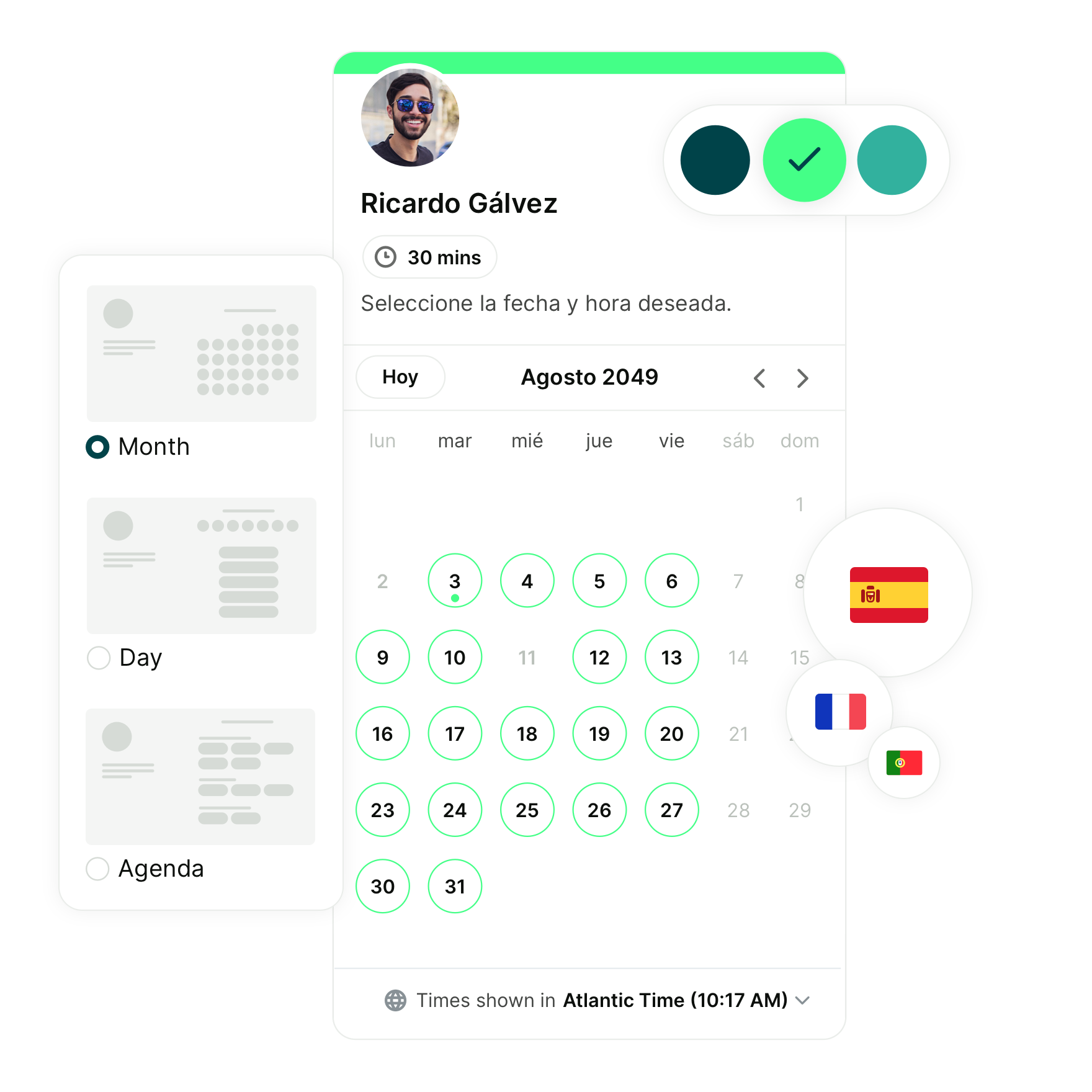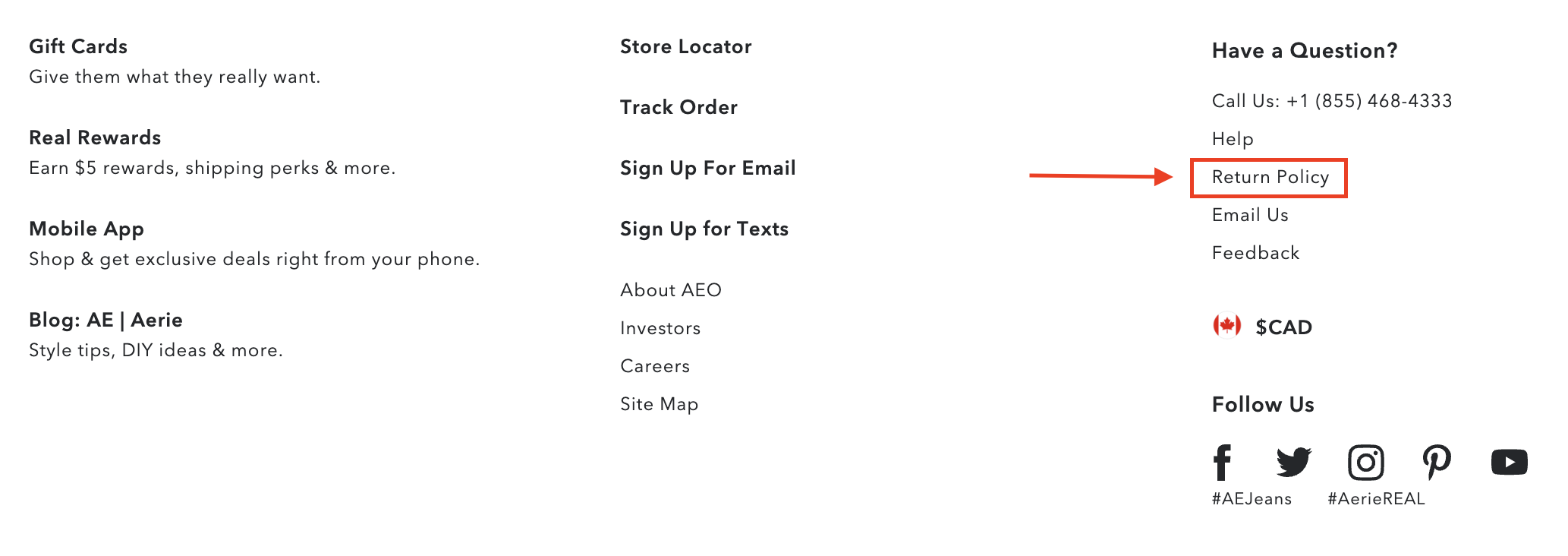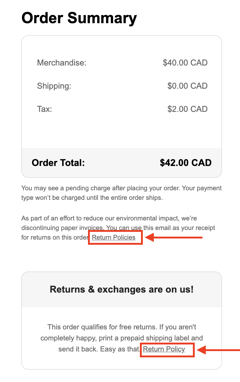Protect Your Small Business with These Refund Policy Examples
Set the stage for smoother transactions, happier customers, and peace of mind with our step-by-step guide to writing return policies.
-min.png?width=100&name=image%20(21)-min.png)
Gabriela Łaba

Ready to book more meetings?

Contents
You've poured your heart and soul into building your small business, carefully selecting products or crafting services that speak to your passion and expertise (and pricing to match).
But what happens when a customer isn't entirely satisfied with their purchase or service experience?
That’s where a well-crafted refund and return policy comes into play. Implementing these can safeguard your business and drive up customer loyalty, keeping them coming back for more.
In this article, we’ll give you a step-by-step guide to crafting your own policies and show you effective, real-world refund policy examples to inspire your own.
But first, let's start with the basics.
What is a refund and return policy?
A refund and return policy is the playbook you turn to when your customer isn’t satisfied with their purchase.
Picture it as a friendly agreement between you and your customers, laying out the options and steps to take if they find themselves less than thrilled with your goods or services.
Types of refund policies
A refund policy is a crucial aspect of any business, and there are several types of refund policies that businesses can adopt. Here are some of the most common types of refund policies:
- Exchange policy: Customers can trade in their item for something of equal or greater value. If they're eyeing that pricier upgrade, they'll just cover the difference.
- Full refund: Offering a full refund hits the reset button on the whole transaction: you take the item back (if physical) or revoke their access (if digital), and the customer gets their money back.
- Store credit: If a customer isn't quite feeling their purchase, offering store credit of equal value is a way to keep the funds within your store, while still ensuring your customer finds something they like. On the services side, this could look like offering a complimentary coaching session or haircut.
-
Partial refund: In cases where items are worn or damaged, a partial refund can be offered. This ensures transparency and helps customers understand the conditions under which they can expect some money back, fostering trust and clarity in the return process.
- Final sale: As the most restrictive option, a final sale is a one-way street—no returns, refunds, or exchanges allowed. This option is best used sparingly, as a final sale might deter some customers from going through with their purchase. This is typically used on heavily discounted items.
- No refund policy: A no refund policy is a type of refund policy where the business doesn't offer refunds under any circumstances. This type of policy is often used for products or services that are non-returnable or non-refundable, such as digital products, personalized items, or services that have already been rendered.
Does your business need a refund policy?
The short answer is YES. Whether you sell physical products, digital items, subscriptions, or services, a refund policy protects both your business and your customers. It’ll help you:
- Boost your bottom line: Without a clear return policy in place, customers may hesitate to purchase from you. A safety net (a.k.a. your return policy) will let customers feel confident buying from you, increasing your sales.
- Save time on customer support: If you lack a clear return system, you and your staff may become overwhelmed by handling refunds on a case-by-case basis. It could also make deescalating angry customers more challenging.
- Improve customer satisfaction: By smoothly and swiftly addressing refunds and returns, you’ll show your customers you value their business and respect their time.
- Safeguard against return fraud: A solid refund policy protects you against potential fraud, such as returning items purchased elsewhere or with falsified receipts.
💡 Pro tip: As you start documenting all of the necessary policies for your business, like your refund and return policy, consider documenting other important small business workplace policies.
What to include in your refund policy
Let's walk through 8 key pieces of information that you should consider including in your refund policy.
1. Core business info
The first piece of the refund policy puzzle is the simplest! Start by providing all of your business information, including company name, address, and contact details.
Abercrombie & Fitch Canada does so right at the top of their Sales Terms page.
2. Returnable vs. refundable products
Your policy should spell out which items can be returned, refunded, or exchanged and which are a firm "no-go." Many businesses choose to mix and match their policies.
📝 For example, you can exclude sale or discounted items from returns, categorize high-ticket items for exchanges, and reserve refunds for regular-priced items. If you’re in the service-based industry, you might just stick with a no-refunds altogether policy.
A great example of this is businesses that sell swimsuits online. Many declare that for sanitary reasons, tops can be returned or exchanged, but bottoms can't. See how Strawberry Milk Mob explains this clearly on their refund policy page:
 3. Condition of items
3. Condition of items
Your policy should state the condition items must be in to be eligible for a return, such as being in original packaging and in good condition. This helps prevent disputes and ensures returned items can be resold.
Most businesses will only accept items in pristine, new condition, with all the tags and wrappings intact. This piece of information isn't relevant for service-based businesses.
Looking at the same example from Strawberry Milk Mob, we can see that they've included item conditions within their refund policy:

4. Time frame
Give customers a clear and firm deadline by which they can ask for returns, refunds, or exchanges.
📝 For example, you may choose to implement a 30-day refund window for coaching sessions.
But if your business sells physical products, it's important to be clear about when the return window starts. Is it from time of purchase or from the day the delivery was made?
In the same Strawberry Milk Mob example, we see that they've decided to opt for a 15-day return period after delivery.

5. Proof of purchase
Don’t forget to require a receipt for every refund—whether it's a digital version or a traditional paper one. Otherwise, people may take advantage of you.
Requiring proof of purchase has also become something that's easier in a digital-first world. It's likely that your POS system or invoicing software will keep a record of customer purchases.
To speed up the return process, you may also require order number or order confirmation details, which is another way to verify proof of purchase.
6. Reasoning
For physical products 👉 Some businesses will solely accept returns if a product is defective or an error was made, while others only require that the product wasn’t used and don’t need any further reasoning.For services 👉 For service-based businesses, refunds are typically granted in two situations: if a customer is unhappy with your service or unable to use it as expected.
7. Detailed return process and shipping instructions
Detail the steps customers need to follow to return an item, including whether they need to cover return shipping costs. Providing clear instructions makes the process smoother for both the customer and your customer service team.
This is especially important if you're running an online store because customers don't have the ability to just walk into your store and talk it through.
As you write out your return process, put yourself in your customers’ shoes and craft your policy to answer all their potential questions.
8. Type of refund
Specify whether customers will receive a cash refund, store credit, or an exchange. This transparency helps manage customer expectations and reduces potential dissatisfaction.
When looking at Strawberry Milk Mob again, we can see that in their policy they outline that they don't offer exchanges and that all returns will be processed for store credit.

Another element that you may include as part of your refund could be restocking fees. If applicable, mention any restocking fees that will be deducted from the refund. This can help cover the costs associated with processing returns and restocking items.
Best practices for writing a refund policy
Seek legal advice
Specific overarching refund laws may already exist depending on which country you do business in. Be sure to double-check that your refund policies are in line with those to avoid possible legal issues.
Write in clear language, avoiding jargon
Your policy needs to be clear and understandable. If you write it in legalese (or just in a confusing manner), you’ll risk needing to field an endless string of questions from befuddled customers.
Don’t forget to use clear headings so customers can easily find the information they want!
Use a template, but don’t just copy it
Our refund and return policy examples are here to help you out, but you’ll need to tailor them to fit your specific business model. Take the time to craft an effective policy now, and you’ll save time and hassle in the long run.
Make your refund policy easily accessible
Once you have your ironclad return policy, the next step is informing your customers. Share your policy in:
Your website footer
Add a link to the policy in your website footer, so that no matter what page your customer is currently perusing, they’ll easily be able to access your return and refund rules.

|
💡Pro-tip: Add a FAQ section to your website about your return policies to ensure customers can easily find the info they need. See Moleskin's example here. |
Booking or purchase confirmation emails
Do you send automated emails after a purchase or booking? Include a link to your refund policy in your booking or purchase confirmation email.
Invoices and receipts
👉 If it’s a digital invoice, include a link to your return policy.
👉 If it’s a physical invoice, include a quick summary of your terms and direct your customers to where they can find more information.
On your checkout or booking page
👉 If you run an e-commerce store, include a link to your policy on the checkout page.
👉 If you run a service-based business, such as a hair salon, tutoring center, or coaching practice, don’t forget to include a link to your refund policy on your booking page.
Real-world refund policy examples for service-based businesses
Service-based businesses often have more complicated refund policies than e-commerce ones. While you can easily return a physical item, you cannot return someone’s time or efforts in the same way.
As a service-based business, you have three choices:
- Opt for an ironclad, no refund policy
- Choose a no refund policy, but offer additional correction services at no charge
- Offer a refund policy with strict rules and guidelines to ensure you don’t lose too much revenue, whether it's a full refund or a partial one.
Browse through all three approaches in the sample refund policies below.
No refund policy example: ReDiscover Psychological Services Inc.
What they did well: Even though ReDiscover doesn’t offer refunds, the business still suggests what customers can do if they aren’t pleased with the services.
No refund policy example with additional services: Balayage House
What they did well: Balayage House clearly explains what a customer needs to do if they aren’t satisfied with their service, including the time frame during which they have to report the issue and what will happen once they do.
Strict refund policy example: About Time Coaching
What they did well: About Time Coaching lays out a step-by-step plan of what a customer must do to qualify for and receive a refund, and the consequences for asking for this refund too often. This policy ensures client satisfaction while protecting the business from repeat or unfair refund requests.
For service businesses, you can also opt to offer partial refunds and clearly explain scenarios where those are granted. For example, if someone's 50% of the way through a coaching package and decide they're not satisfied, you may offer a partial refund instead of a full one.
|
🆘 Have trouble with last-minute appointment cancellations? Get tips for crafting your booking policy and cancellation policy to safeguard your bottom line. |
Real-world refund policy example for ecommerce businesses
If you run an online store, you'll have a few more things that you'll need to include in your refund policy. These things can include:
- Shipping instructions
- If you offer free returns or if customers have to pay the shipping costs
- Restocking fees (if applicable)
30-day return policy example: Cafe Blue
What they did well: Cafe Blue lays out an easy-to-read, bulleted list detailing what steps a customer must take to return an item. The company outlines all the necessary details, including the time frame, item conditions, contact info, return address, and processing time.
|
💡Pro-tip: Still intimidated by the prospect of writing your return and refund policy? Try using a policy generator to help you get started. |
Store credit policy: Strawberry Milk Mob
Alright, we've used this example a few times but it's just so good! If you're running an online clothing business, you'll likely experience a higher rate of return requests. So, putting in the measure of offering store credit only for all refunds is a way to minimize the mountain of return requests you likely process.

What they did well: Across their entire refund policy, Strawberry Milk Mob makes their terms very clear across:
- How returns are processed
- Return period (and when the timer starts)
- What items are considered final sales vs. items that are eligible for store credit.
Final thoughts
While it may seem like a small detail, your refund policy can significantly impact your business's long-term success and reputation.
Your policy will be the safety net for both you and your customers: it’ll safeguard your small business’ interests while showing your clients their satisfaction truly matters to you. So, don't wait—take the time to craft your refund policy now, and you'll definitely thank yourself later.
Refund policy example FAQ
Should I offer a return policy?
How do I write a refund policy for a product-based business?
Return and refund policies are essential components of a retailer's customer service strategy, highlighting their importance for both legal compliance and customer satisfaction.
An example of a refund policy for a product-based business could be: “We offer a 30-day refund policy for all unused and unopened products. Customers may return items for a full refund within 30 days of purchase, provided they are in their original condition and packaging. Return shipping costs are the customer’s responsibility. Please fill out our return form (found below) and send it along with the product and your receipt to: insert your address here.”
How do I write a refund policy for services?
Writing a refund policy for services requires careful consideration of your business practices and customer expectations. Here's a step-by-step guide:
-
Clearly define the circumstances under which refunds are available, such as dissatisfaction with the service or failure to meet agreed-upon objectives.
-
Specify the process for requesting a refund, including any documentation or communication requirements.
-
Address any limitations or exceptions to the refund policy, such as non-refundable deposits or cancellation fees.
-
Communicate the refund policy to clients before their service to manage expectations and prevent misunderstandings.
Subscribe to our newsletter
Get productivity tips, news, articles and resources.-min.png)
Written by
Gabriela Łaba
Gabriela is an (everything bagel) seasoned copywriter who has been banging out copy for brands both big and small since 2016. In her free time, you can find her buying Halloween decorations, reading, and trying to force her cat to love her.



.png?width=1600&height=1200&name=booking_page_style@2x%20(2).png)
